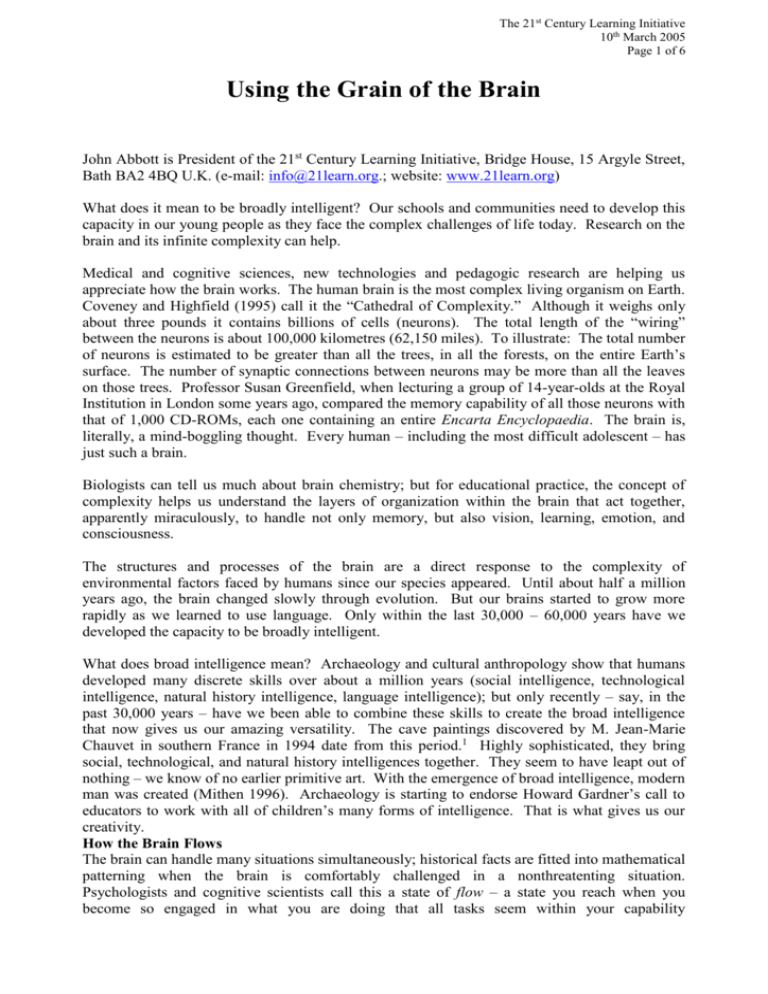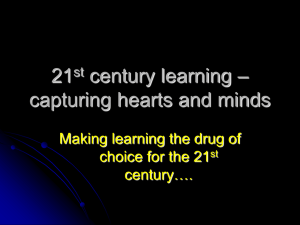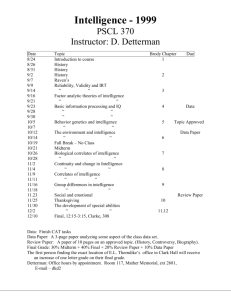Using the Grain of the Brain - The 21st Century Learning Initiative
advertisement

The 21st Century Learning Initiative 10th March 2005 Page 1 of 6 Using the Grain of the Brain John Abbott is President of the 21st Century Learning Initiative, Bridge House, 15 Argyle Street, Bath BA2 4BQ U.K. (e-mail: info@21learn.org.; website: www.21learn.org) What does it mean to be broadly intelligent? Our schools and communities need to develop this capacity in our young people as they face the complex challenges of life today. Research on the brain and its infinite complexity can help. Medical and cognitive sciences, new technologies and pedagogic research are helping us appreciate how the brain works. The human brain is the most complex living organism on Earth. Coveney and Highfield (1995) call it the “Cathedral of Complexity.” Although it weighs only about three pounds it contains billions of cells (neurons). The total length of the “wiring” between the neurons is about 100,000 kilometres (62,150 miles). To illustrate: The total number of neurons is estimated to be greater than all the trees, in all the forests, on the entire Earth’s surface. The number of synaptic connections between neurons may be more than all the leaves on those trees. Professor Susan Greenfield, when lecturing a group of 14-year-olds at the Royal Institution in London some years ago, compared the memory capability of all those neurons with that of 1,000 CD-ROMs, each one containing an entire Encarta Encyclopaedia. The brain is, literally, a mind-boggling thought. Every human – including the most difficult adolescent – has just such a brain. Biologists can tell us much about brain chemistry; but for educational practice, the concept of complexity helps us understand the layers of organization within the brain that act together, apparently miraculously, to handle not only memory, but also vision, learning, emotion, and consciousness. The structures and processes of the brain are a direct response to the complexity of environmental factors faced by humans since our species appeared. Until about half a million years ago, the brain changed slowly through evolution. But our brains started to grow more rapidly as we learned to use language. Only within the last 30,000 – 60,000 years have we developed the capacity to be broadly intelligent. What does broad intelligence mean? Archaeology and cultural anthropology show that humans developed many discrete skills over about a million years (social intelligence, technological intelligence, natural history intelligence, language intelligence); but only recently – say, in the past 30,000 years – have we been able to combine these skills to create the broad intelligence that now gives us our amazing versatility. The cave paintings discovered by M. Jean-Marie Chauvet in southern France in 1994 date from this period.1 Highly sophisticated, they bring social, technological, and natural history intelligences together. They seem to have leapt out of nothing – we know of no earlier primitive art. With the emergence of broad intelligence, modern man was created (Mithen 1996). Archaeology is starting to endorse Howard Gardner’s call to educators to work with all of children’s many forms of intelligence. That is what gives us our creativity. How the Brain Flows The brain can handle many situations simultaneously; historical facts are fitted into mathematical patterning when the brain is comfortably challenged in a nonthreatenting situation. Psychologists and cognitive scientists call this a state of flow – a state you reach when you become so engaged in what you are doing that all tasks seem within your capability The 21st Century Learning Initiative 10th March 2005 Page 2 of 6 (Csikszentmihalyi 1990). This state enables us to react to our environment while also thinking about many abstract matters. The brain handles this complexity through several layers of selforganization and vast interconnecting networks. Once established, traces of these networks appear to survive almost indefinitely and are frequently used as solutions to new problems and as the basis for new ideas. Neurologists can now see some forms of memory in operation. Through magnetic resonance imaging (MRI), they watch specific patterns of activity within the brain light up on a computer screen. To the researchers’ surprise, memory exists in many locations in the brain, not just one place. Some people liken memory to a hologram where the whole exists in all the parts. Memory traces seem to follow neural networks that the individuals – at the time of original thought – found most to their advantage, even if only for a short time. Nothing is ever irretrievably lost, though we still do not know how we can access memory more effectively at some life stages than at others. If part of the network is later activated, the brain may well question why it is not being asked to complete the original set of connections. Going with the Grain of the Brain All brain activity occurs spontaneously, automatically, in response to challenge. The brain does not have to be taught to learn. To thrive, the brain needs plenty of stimulation, and it needs suitable feedback systems. Effective learning depends on emotional energy. We are driven (the ancestral urges of long ago) as much by emotion as by logic. Children – and adults – who learn about things that matter to them are far more resilient and determined when they face problems than are people who seek external rewards. When in trouble, people with intrinsic motivation search for novel solutions, whereas extrinsically motivated people look for external causes to blame for their failure. The brain is essentially a survival system, and emotional well-being may be more essential for survival than intellectual well-being. Too much stimulation, however, at any stage in life, turns a challenge into a threat. The brain deals with threat easily. It just turns off – as MRI dramatically shows. Give a person an interesting mental task, and many parts of the brain are seen to light up. Persistently insult that person, and the brain goes into a form of mental defence. The lights literally go out. Downshifting – a phenomenon long recognized by psychologists – is a strictly physiological defence mechanism. Research suggests that working effectively at a challenging task requires significant amounts of reflection – a critical part of brain functioning (Diamond 1995). No two brains are exactly alike; thus, no enriched environment will completely satisfy any two people for an extended period. Challenge and interactivity are essential. Passive observation is not enough. “Tell me and I forget. Show me and I remember. Let me do it and I understand,” says the ancient Chinese proverb. Learning What Matters With our new understanding of the brain, we are in an excellent position to make it possible for people to become better learners. The implications of this new knowledge for society and for the economy are massive. Ernest Hall, a successful English entrepreneur understands the transforming power of learning. He was born in a northern industrial town near Manchester. His parents knew long periods of unemployment in the textile trade. One afternoon, when he was 8 years old, his teacher played a recording of “Apollo’s Lyre.” Ernest was spellbound; here was a form of beauty that was to transform his life. His family managed to obtain an old piano. By age 12, Ernest played so well that his parents urged him to leave school and earn his living by playing the piano in pubs. The 21st Century Learning Initiative 10th March 2005 Page 3 of 6 “No,” said Ernest, “I love music too much to trivialize it. I will make enough money to play the piano properly.” That is exactly what he did. For years he worked in the textile industry, with great success – and continued practicing the piano. By his early 50s, he had bought the closed-down Dean Clough Mills and created an amazing complex that today provides employment for more than 3,000 people in an array of high-tech and other businesses, including a mill – and that reserves a quarter of its space for art galleries, working studios, concert halls, and exhibition spaces. This complex vividly demonstrates that living, learning, and working – beauty and economic productivity – are all deeply interconnected. To celebrate his 65th birthday, Ernest fulfilled a dream: He performed Bartok’s First, Second, and Third Piano Concertos, accompanied by the Leeds Sinfonia Orchestra. His CDs sell alongside those of the greatest pianists of our day. Ernest believes in the potential of all young people to develop their particular abilities. “I discovered my interest,” he says, “before the crushing routines of my little school would have reduced me to a mere cog in a machine. Ability is not innate. It exists like a shadow of ourselves when we are willing to stand in front of a bright light… We must say to every child, ‘You are special. You are unique; but to develop your genius you have to work at it, and stick with it year after year.’” Creativity does not depend on privilege, nor does learning necessarily follow from teaching. Thus the old complaint of the teacher: “I taught them everything I ever knew, but they were so uninterested that they learned nothing!” Contrast that with David Perkins (1992), writing in Smart Schools: “Learning is a consequence of thinking” (p.78). We should remind every child of this statement each day.” How Do We Create Intelligence? The understanding of learning will become the key issue of our time. The creation of intellectual capital has been going on with every generation for millions of years, with perhaps one exception – and that is what has happened over the past five or six generations. Until the early 1800s, people learned in real-life, on-the-job situations. Then our industrial society required people to develop no more than a range of functional skills (such as reading, writing, and calculation) that allowed them to fit into the dull routines of manufacturing. Schools ignored the more inclusive skills that enabled people to make sense of things for themselves in earlier ages. For much of the past century or more, the spontaneous, deep learning of the Toms and Ernests of this world has existed largely outside the formal education system of Western industrial nations. The ability to think about your own thinking (metacognition) is essential in a world of continuous change. Through metacognition, we can develop skills that are genuinely transferable. These skills are linked to reflective intelligence, or wits. As never before, the human race needs all the wits it can muster. Being able to step back as a specialists and reflect – to honestly re-evaluate what you are doing from a general perspective – is naturally developed in the rich, collaborative, problem-solving, and uncertain world of the apprentice, as opposed to the tasks, schedules, and measurable activities of the formal classroom. Expertise requires much content knowledge – and metacognition. This deep reflective capability is what helps us develop new possibilities. The 21st Century Learning Initiative 10th March 2005 Page 4 of 6 A New Model of Learning A model of learning that could deliver expertise is ours for the asking. It would work on the basis of the biological concept of weaning – giving very young children plentiful help and direction, and then reducing this direction progressively as children master more and more skills. In this model, as adolescence ends, young people will already have taken full responsibility for directing their own learning. The age of 18 should mark not the beginning of independent learning but the age at which young people perfect that art and know how to exercise it responsibly. Formal schooling, therefore, must start a dynamic process through which pupils are progressively weaned from their dependence on teachers and institutions and given the confidence to manage their own learning. Surely it should be the child who is tired at the end of the term, and not the teacher. To achieve this model of learning, we must reappraise the school system and its current use of resources and turn it upside down and inside out. Early childhood learning matters enormously. We must progressively show the youngest children that a lesson about American history, for example, can also be a lesson about how to learn how to learn and remember. As children grow older, they start to become their own teachers. The older the child becomes, the more he or she becomes a productive resource of value to the community (Abbott 1994). In such a model, we should create smaller classes in the early years of elementary education (using developmentally appropriate styles of teaching) and progressively provide children with an ever-richer array of learning resources and situations. Learning need not be confined to an institution – it must become a total community responsibility. It is not merely teachers who can teach, not just pupils who need to learn, and certainly not just the classroom that can be the major access point to knowledge, information, and skills. Our new understanding about learning is paralleled by radical developments in technology. The technological revolution holds the power to alter our education system, our work, and our culture. Indeed, this revolution puts learning and our traditional, conventional education systems on a collision course. The essence of the integrated, universal, multimedia digital network is discovery – the empowerment of the human mind to learn spontaneously, independently, and collaboratively, without coercion. Such a new learning environment would be highly compatible with the natural functioning of the brain; with what we know about human aspirations; and, in particular, with the adolescent’s need to feel involved and of value. It offers the greatest hope for an improvement in people’s intelligence and the development of thoughtfulness. The current crisis in learning has originated not so much in the failure of our classrooms as in the failure of our communities to capture the imagination, involvement, and active participation of young people. A society motivated by a vision of thoughtfulness will quickly recognize that broadly intelligent young people will revitalize the whole community. We must escape from the 19th-century assumption that learning and schooling are synonymous. Good schools alone will never be good enough – we need communities that think differently, work differently, and are even designed and built differently.2 The 21st Century Learning Initiative 10th March 2005 Page 5 of 6 Such communities would make for a better, more exciting world in which living, working, and learning come together again and recreate vibrant, self-sustaining communities that will be an invigorating world within which to live. The French Ministry of Culture Web site includes photos of the Chauvet cave drawings at http://www.culture.fr/culture/gvpdaen.htm. 2. This article is based on the work of the 21st Century Learning Initiative (draft synthesis, December 1996). 1. Resources Abbott, J. (1994). Learning Makes Sense: Recreating Education for a Changing Future. London: Education 2000. Bereiter, C., and M. Scardamalia. (1993). Surpassing Ourselves: An Inquiry into the Nature and Implications of Expertise. Chicago: Open Court. Bruer. J. (1993). Schools for Thought: A Science of Learning in the Classroom. Cambridge: Massachusetts Institute of Technology Press. Caine, R. N., and G. Caine. (1991). Making Connections: Teaching and the Human Brain. Alexandria, Va.: ASCD. Calvin, W.H. (1996). How Brains Think: Evolving Intelligence, Then and Now. New York: Basic Books. Coveney, P., and R. Highfield. (1995). Frontiers of Complexity: The Search for Order in a Chaotic World. New York: Fawcett Columbine. Csikszentmihalyi, M. (1990). Flow: The Psychology of Optimal Experience. New York: Harper Perennial. Diamond, M. (July/September 1995). “The Significance of Enrichment.” The In Report. Goleman, D. (1995). Emotional Intelligence: Why It Can Matter More Than IQ. London: Bloomsbury. Greenspan, S. (1996). The Growth of the Mind, and the Endangered Origins of Intelligence. New York: Addison Wesley. Kohn, A. (1993). Punished by Rewards. Boston: Houghton Mifflin. Kotulak. R. (1996). Inside the Brain. Chicago: Andrews and McMeel. Le Doux, J. (1996). The Emotional Brain: The Mysterious Underpinnings of Emotional Life. New York: Simon and Schuster. Mithen, S. (1996). The Prehistory of the Mind. London: Thomas and Hudson. The 21st Century Learning Initiative 10th March 2005 Page 6 of 6 Perkins, D. (1992). Smart Schools: From Training Memories to Educating Minds. New York: Free Press. Perkins, D. (1995). Outsmarting IQ: The Emerging Science of Learnable Intelligence. New York: Free Press. Sylwester, R. (1995). A Celebration of Neurons: An Educator’s Guide to the Human Brain. Alexandria, Va.: ASCD. Wills, C. (1993). The Runaway Brain: The Evolution of Human Uniqueness. London: Basic Books.







